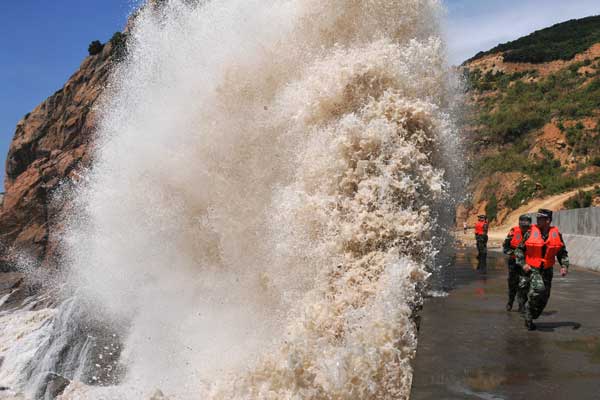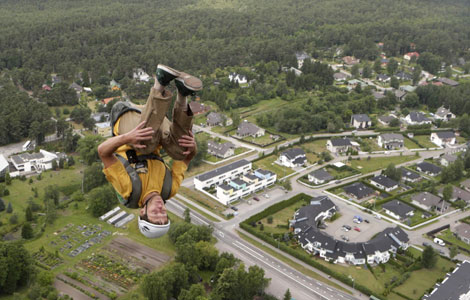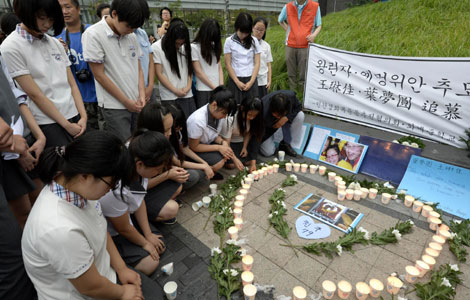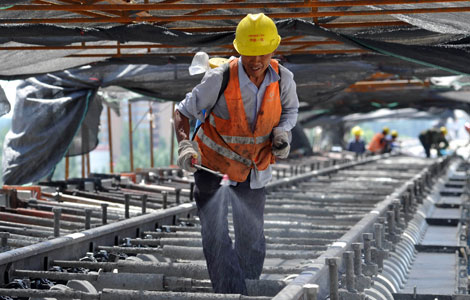Residents flee from landslides
Updated: 2013-07-13 01:32
By Huang Zhiling (China Daily)
|
||||||||
500 disaster victims transported to Chengdu after two days in shelter
Relief from treacherous landslides for 77-year-old Ju Shumei came in the form of a rural resort stay in Zhongxin town, Dujiangyan, Sichuan province, on Friday afternoon.
Since May 26, the Shanghai native had been trying to escape from the searing summer heat to a mountain resort in Sanxi village about 8 kilometers from Zhongxin High School. But on Wednesday, when the downpour began and the landslides followed, burying eight rural resorts, Ju and other seniors staying in Sanxi were evacuated to the school.
 |
|
As the fierce gales of typhoon Soulik approach, border troops were met with big waves as they patrolled the coast of Wenling, Zhejiang province. Jia Ce / for China Daily |
Ju took the news of her move with a wide smile.
Heavy rains have lashed China hard since Sunday, with at least 30 people dead and 67 people missing as of Thursday. Floods and landslides have affected about 3.73 million homes and counting.
In Dujiangyan where Ju is located, 22 people have been confirmed dead and 103 were missing in landslides on Friday. It was the most severe rainstorm the city had experienced since 1954.
Ju was diagnosed with lung cancer in 2011. Without an operation, she takes traditional Chinese medicine and has lived in Zhongxin for several months each year since 2012.
"The air in the town is beneficial to my health and I will not leave for Shanghai until September," she said.
While Ju preferred to stay, almost all tourists visiting from outside Dujiangyan who had stayed in the high school shelter left the city on Friday.
"Since the shelter was set up on Wednesday, six buses have transported tourists and their relatives who came to look for them to Chengdu … where they can go home," said Chen Jianfu, an official in Zhongxin. "Before Friday afternoon, some 500 tourists and their relatives were living in the shelter."
Zhongxin is adjacent to Mount Qingcheng, the birthplace of Chinese Taoism, and its temperatures are two or three degrees lower than in Chengdu. An increasing number of senior citizens have been living in Zhongxin for several months each year to breathe in the fresher air and escape the summer heat. That is, before the landslides made its way through.
"The landslide will have an adverse impact on tourism in Zhongxin and neighboring Qingcheng town where Mount Qingcheng is located," said Ma Fang, a rural resort owner in Qingcheng town. "Before the landslide, 23 seniors lived in my resort. They all have left."
Since the landslide, Mount Qingcheng has been closed and an alert barrier has been set up about 500 meters away from the gate to the mountain.
"More havoc would have resulted in any city or county without the Dujiangyan Irrigation Project," said Liu Gang, an expert in the irrigation project.
In ancient times, Chengdu Plain, now one of China's most populous and important agricultural regions, suffered from incessant flooding from the Minjiang River in the summer seasons. In the winters, the plain withered in droughts.
Around 256 BC, Sichuan governor Li Bing started building Dujiangyan, now the world's oldest irrigation project still in operation.
He divided Minjiang into two by building a midstream dam.
When the river swells in the flood seasons, floodwater is diverted away from Dujiangyan. The plain has been more or less spared from flooding and drought for more than 2,000 years thanks to the project.
In 2000, the project was listed as a World Cultural Heritage sites by the United Nations Educational, Scientific and Cultural Organization.
Severe rainstorm
Beichuan Qiang autonomous county in northern Sichuan was one of the hardest-hit regions in the rainstorm.
Heavy rains have flooded the ruins of its old county seat that was ravaged by the Wenchuan earthquake in Sichuan in 2008 and killed nearly 70,000 people. Some 20,000 perished in Beichuan.
"The deepest water in the ruins was 7 meters," said Wang Shoulei, officer in Beichuan.
After the ruins were inundated, netizens questioned the necessity of protecting them because they had often been affected by floods after the quake.
Refuting the allegation that 2.3 billion yuan had been spent on the ruins, Jing Fuguo, an information officer with the headquarters in charge of the protection of the ruins in Beichuan, said: "Sichuan has invested 470 million yuan in an earthquake memorial museum, protection of the ruins and reconstruction of a town in Beichuan. Less than 100 million yuan has been spent on the protection of the ruins."
Some supporters think it is worthwhile to protect the ruins because many relatives travel to the site to mourn their loved ones buried there during traditional holidays each year.
"People who want to understand the destruction of the earthquake also visit the site," said Peng Jinchuan, senior engineer of the Sichuan Provincial Seismic Bureau.

 BASE jumpers celebrate their annual event
BASE jumpers celebrate their annual event
 S Korean students mourn Chinese victims of air crash
S Korean students mourn Chinese victims of air crash
 Constructive mood at talks
Constructive mood at talks
 Masks reveal unknown worlds
Masks reveal unknown worlds
 Pathfinder pianist
Pathfinder pianist
 Surviving students hosted by consulate
Surviving students hosted by consulate
 China investigates GSK executives for bribery
China investigates GSK executives for bribery
 China, Russia complete 3-day joint naval drill
China, Russia complete 3-day joint naval drill
Most Viewed
Editor's Picks

|

|

|

|

|

|
Today's Top News
Chinese companies in the US go on talent hunt
Nokia aims to recapture market
Samsung expands global footprint
China, US explore new treaty
Asiana apologizes for air crash
Asia spending too little on poor: report
More Americans favor immigration
Saudi princess charged with US human trafficking
US Weekly

|

|






